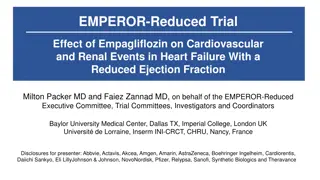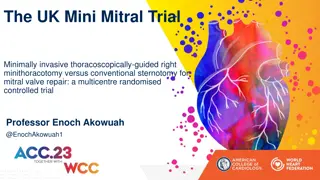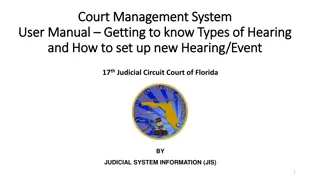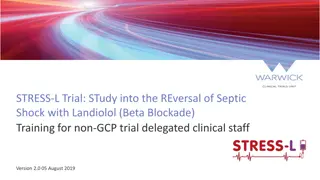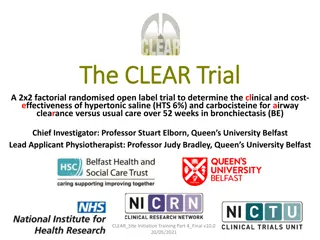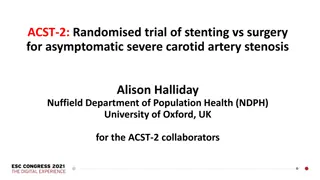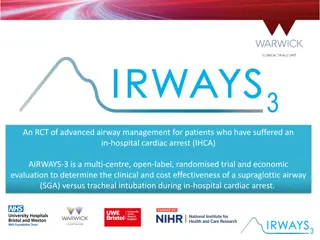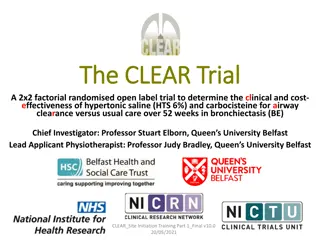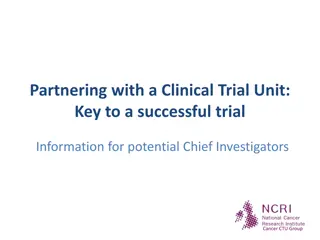STOPAH Trial Parth Kothari MS3 Case Study
"Case study of a 49-year-old male with alcohol dependence disorder, presenting with abdominal pain, altered mental status, and changes in skin color. Vitals, lab results, Alcoholic Hepatitis, Pathogenesis, Severity Classification, Prednisolone and Pentoxyphylline Trials discussed."
Download Presentation

Please find below an Image/Link to download the presentation.
The content on the website is provided AS IS for your information and personal use only. It may not be sold, licensed, or shared on other websites without obtaining consent from the author.If you encounter any issues during the download, it is possible that the publisher has removed the file from their server.
You are allowed to download the files provided on this website for personal or commercial use, subject to the condition that they are used lawfully. All files are the property of their respective owners.
The content on the website is provided AS IS for your information and personal use only. It may not be sold, licensed, or shared on other websites without obtaining consent from the author.
E N D
Presentation Transcript
MISUSE OF ORAL CONTRACEPTIVES WITH LIFE THREATENING COMPLICATION IN A CASE OF FIBROID UTERUS DR. NEHA ELLATH Under the guidance of DR. VIDYA GAIKWAD PROF and HOU DEPT. OF OBGY UNIT II
CASE A 37 year old female, P3L3 Tubectomised, a homemaker of low socio economic class from Khed, Pune. Was brought to Dr. D. Y. Patil Hospital casualty with Complaints of (her mother being the informant) P/V bleeding with passage of clots since 10 days Headache and Altered sensorium since 3-4 days Vomiting since 2 days No H/O of trauma, ENT bleed, loss of consciousness, seizures
MENSTRUAL and OBSTETRIC HISTORY Menstrual history: Irregular menstrual bleeding since 1 year LMP: not known since 1 year: Irregular, heavy flow with passage of clots and dysmenorrhea 1 year ago: regular, moderate flow no h/o passage of clots or dysmenorrhea Obstetric history: Married since 16 years P3L3 (full term normal deliveries) Last child birth 11 years ago Tubectomised
PAST HISTORY Patient had similar menstrual complaints, Irregular, heavy menstrual bleeding with passage of clots and dysmenorrhea 1 year ago for which she was prescribed Oral Contraceptive Pills OVRAL-G Norgestrel 0.5mg + Ethinyl Estradiol 50 g for 3 cycles However patient had been taking OCP s on and off without prescription since 1 year to control heavy menstrual bleeding and for relief of dysmenorrhea Her mother in addition, gives history of her daughter taking these pills sometimes 2 or 3 times a day (i.e. 100-150 g of Ethinyl Estradiol) No history of taking anticoagulants, bleeding diathesis, hypertension, diabetes mellitus, thyroid illness, tuberculosis, asthma, epilepsy.
PERSONAL AND FAMILY HISTORY Personal history: No bowel or bladder complaints No addictions No known drug allergies Family history: Not significant
GENERAL EXAMINATION: Patient was conscious but drowsy Glasgow Coma Score (GCS): 13, Eye response-3 Verbal response-4 Motor response-6 (E3V4M6) Afebrile, Pulse: 68/min, Respiratory rate: 18/min, Blood pressure: 100/50 mm of Hg SpO2 :98% on room air Pallor +++ No icterus, cyanosis, edema, generalized lymphadenopathy CNS EXAMINATION: Bilateral pupils equal & reactive to light Moving all 4 limbs however paucity of movements on right side of body
PER ABDOMEN EXAMINATION: soft non tender PER VAGINAL EXAMINATION: Local examination: bleeding ++ Speculum examination: bleeding ++ Bimanual examination: uterus 12 week size Anterior and lateral fornicial fullness noted Cervix dilated ? Fibroid polyp felt inside the os CARDIOVASCULAR SYSTEM: S1 S2 heard RESPIRATORY SYSTEM: air entry equal on both sides
USG (abdomen+ pelvis) findings: Bulky uterus with Submucosal fibroid measuring approx. 6x6cm showing peripheral vascularity on Doppler compressing and pushing lower endometrium on left lateral side with minimal streak of fluid in lower endometrial cavity CT Brain findings: Intraparenchymal hemorrhage in the left parieto-temporo occipital region measuring approx. 3.8x 2.7x 2.2cm Mass effect by effacement of body, temporal and occipital horn of left lateral ventricle. Midline shift of 8mm to right side with subfalcine and uncal herniation. MRI Brain showed Cerebral Venous Sinus Thrombosis
Lab investigations: Hb: 8.8gm/dL Plt count: 148,000/ L PT: 16.2sec INR: 1.4 UPT negative Rest labs WNL
DIAGNOSIS Patient was diagnosed with Submucosal fibroid with Cerebral Venous Sinus Thrombosis with Left parieto-temporo occipital bleed with Midline shift to right side
MANAGEMENT - MEDICAL IV Antibiotics Inj. Mannitol Inj. Levetiracetam Tab. Primolut N 5mg TDS (for P/V bleeding) 4 PCV 4 FFP s
MANAGEMENT - SURGICAL Patient underwent left fronto temporo parietal decompressive craniectomy with left temporal hematoma evacuation from superior temporal gyrus Post operative period was uneventful without neurological deficit
FOLLOW UP Patient was discharged on Tab. Warfarin 2mg OD x1month Inj. Enoxaparin 0.6cc sc BD x1month with weekly PT/INR monitoring Tab. Primolut N 5mg TDS x21days Patient is currently being followed up in gynecology and neurosurgery OPD and hysterectomy has been planned after a month
DISCUSSION Women who use estrogen containing hormonal contraceptives are at increased risk for venous thrombosis and thromboembolism.(10) The progesterone-only oral contraceptives and the levonorgestrel-releasing IUDs were not associated with venous thrombosis.(10) Consumption of oral contraceptive pills (OCP) is a known risk factor for cerebral venous sinus thrombosis (CVST) among women. Pulmonary embolism and cerebral thrombosis, both venous and arterial, are 7 to 10 times more frequent in the pill users than in the non-users.(12)
DISCUSSION (CONT.) Venous thrombosis and thromboembolism are due to a derangement in the clotting mechanism in the platelet aggregation, increased fibrinogen, factor VII, VIII, X and decreased fibrinolysis caused by the estrogen component of the pill.(9,12) Leiomyoma (fibroid) is itself erythropoietic and Polycythaemia increases the risk of thromboembolism(11) Islands of extramedullary erythropoiesis have been documented, a high level of erythropoietin activity has been reported within uterine Leiomyomas(11) The tumor may press on the ureter and affect the erythropoietic function of the kidney(11) Arteriovenous shunts have also been found in these tumours and these may also play a role(11)
DISCUSSION (CONT.) When compared with higher-dose 50 g estrogen OC s, lower estrogen- dose 30-35 g ethinyl estradiol (EE) OC s have less risk of a thromboembolic event.(2) A Danish study showed that combination OC s with 20 g of EE have an 18% further less risk compared with 30 to 40 g OC s after adjustment for duration of use.(3)
RECOMMENDATIONS OCPs are ideally started on any day between day 1 and 5 of the cycle, given for 21 days and stopped. This will be followed by withdrawal bleed. A new packet of pills is started counting the 1st day of withdrawal bleed as day 1. The patient should be called for follow-up after 3 months for the assessment of blood pressure and enquired for the presence of any other problems. Thereafter, annual visit is required for assessing side effects, checking blood pressure, and evaluating glucose intolerance and lipids. OCPs need to be stopped in the presence of any side effects or if abnormal glucose tolerance or dyslipidaemia is detected.
RECOMMENDATIONS (cont.) Counselling regarding risks, benefits and contraindications should be done in detail before starting OCPs Obtaining a thorough past, medical and family history, calculating the BMI are important before prescribing OCPs Proper patient selection is necessary to minimise risks associated with OCP use Increased risk of DVT in women using OCPs warrants that DVT should be ruled out in all women on OCPs(2)
RECOMMENDATIONS (cont.) In women with chronic menorrhagia it is important to rule out haemoglobinopathies and coagulopathies(1) Careful monitoring of women who take OCPs for venous thrombosis, hypertension, lipid profile, breast, cervical and liver cancer is essential OCP use in obese women have additional metabolic risk and should be carefully monitored by appropriate surveillance Levonorgestrel intrauterine device can be offered in those with menorrhagia
CONCLUSION Over-the-counter (OTC) availability of oral contraceptives is a controversial subject and not just because of the political debates over reproductive health care. Benefits could include wider availability, no need for provider prescription lower costs due to absence of associated healthcare expense general cost decline of most medications which have gone OTC in the past Concerns include Misuse lack of supervision increased adverse effects as a result of inadequate medical screening prior to use
REFERENCES 1. Martinelli I, Sacchi E, Landi G, et al. High risk of cerebral-vein thrombosis in carriers of a prothrombin-gene mutation and in users of oral contraceptives. N Engl J Med 1998;338(25):1793-1797. Gerstman BB, Piper JM, Tomita DK, et al. oral contraceptive estrogen dose and the risk of deep venous thromboembolic disease. Am J Epidemiol 1991;133(1):32 37. Lidegaard O, Lokkegaard E, Svendsen AL, et al. Hormonal contraception and risk of venous thromboembolism: national follow-up study. BJM 2009;339:b2890. Comp PC. Should coagulation tests be used to determine which oral contraceptive users have an increased risk of thrombophlebitis? Contraception 2006;73(1):4 5. Spitzer WO, Lewis MA, Heinemann LA, et al. Third generation oral contraceptives and risk of venous thromboembolic disorders: an international case control study. Transnational Research Group on Oral Contraceptives and the Health of Young Women. BMJ 1996;312(7023):83 88. Heinemann LA, Dinger JC, Assmann A, et al. Use of oral contraceptives containing gestodene and risk of venous thromboembolism: outlook 10 years after the third-generation pills scare . Contraception 2010;81(5):401 407. Stegeman BH, Bastos M, Rosendaal FR, et al. Different combined oral contraceptives and the risk of venous thrombosis: systematic review and network meta-analysis. BMJ 2013;347:f5298. Effect of different progestagens in low estrogen oral contraceptives on venous thromboembolic disease. World Health Organisation Collaborative Study of Cardiovascular Disease and Steroid Hormone Contraception. Lancet 1995;346(8990):1582-1588. Clinical gynecologic endocrinology and infertility, Leon Speroff and Marc A. Fritz Berek & Novak s Gynecology Jeffcoate s Principles of Gynaecology Shaw s Gynaecology 2. 3. 4. 5. 6. 7. 8. 9. 10. 11. 12.




